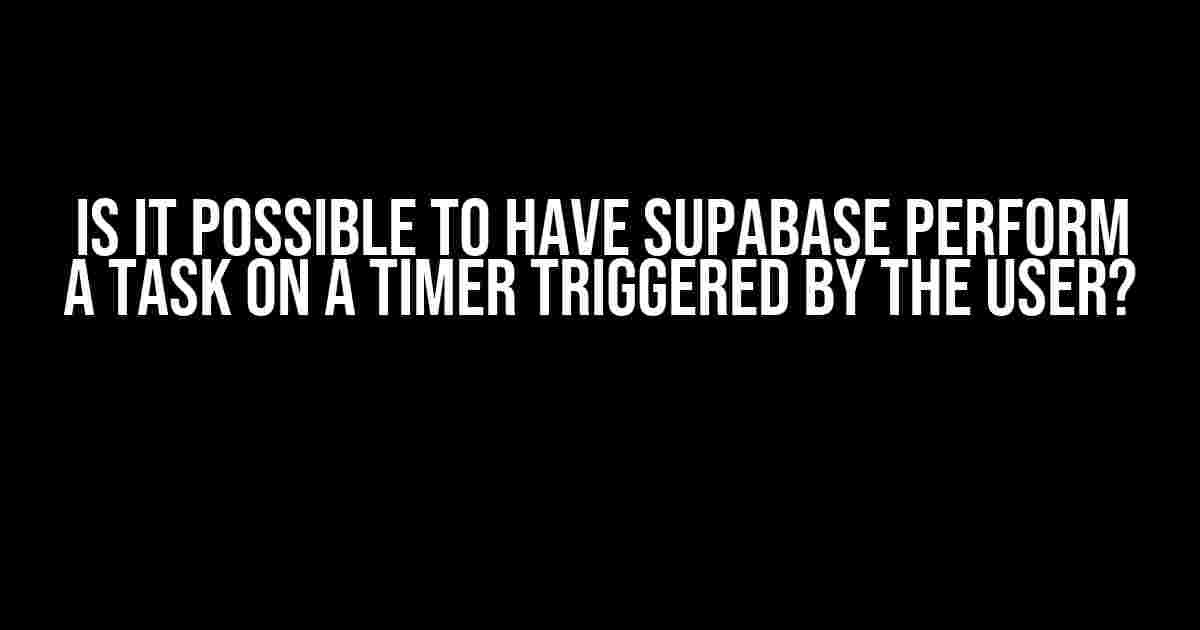What is Supabase?
Before we dive into the main topic, let’s quickly introduce Supabase. Supabase is an open-source alternative to Firebase, allowing developers to build fast, scalable, and secure applications with ease. It provides a suite of tools, including a PostgreSQL database, edge networking, and authentication, all under a single roof.
The Challenge: Running Tasks on a Timer in Supabase
Supabase is designed to handle real-time data and provide instant responses to user interactions. However, when it comes to running tasks on a timer, things get a bit more complicated. Unlike traditional backend frameworks, Supabase doesn’t have built-in support for scheduled tasks or cron jobs. So, how can we overcome this limitation?
Option 1: Using Supabase Functions with a Timer Trigger
One possible solution is to leverage Supabase Functions, which allow you to write server-side code in JavaScript or TypeScript. By combining Supabase Functions with a timer trigger, you can execute tasks on a schedule.
// Create a Supabase Function with a timer trigger
export async function scheduledTask() {
// Get the current timestamp
const now = new Date();
// Perform the task (e.g., send a notification or update a database record)
await supabase
.from('notifications')
.insert({ message: 'Hello from Supabase!', timestamp: now });
// Log a success message
console.log('Task executed successfully!');
}
In this example, the `scheduledTask` function is triggered by a timer, which can be set using the Supabase dashboard or the Supabase CLI. When the timer fires, the function executes, performing the desired task.
Option 2: Utilizing Edge Functions with a Cache-Control Header
Another approach is to use Edge Functions, which run at the edge of the network, close to your users. By setting a Cache-Control header with a specific TTL (time to live), you can create a makeshift timer that triggers the Edge Function.
// Create an Edge Function with a Cache-Control header
export async function edgeFunction(req, res) {
// Set the Cache-Control header with a TTL of 1 minute
res.setHeader('Cache-Control', 'public, max-age=60');
// Perform the task (e.g., update a database record or send a notification)
await supabase
.from(' EdgeFunctionCalls')
.insert({ timestamp: new Date() });
// Return a response to the client
res.status(200).send('Task executed successfully!');
}
In this scenario, the Edge Function is triggered when the Cache-Control header expires, which in this case is set to 1 minute. When the timer fires, the Edge Function executes, performing the desired task.
Triggering Tasks on User Interaction
Now that we’ve explored the possibilities of running tasks on a timer in Supabase, let’s discuss how to trigger these tasks on user interaction.
Using Realtime Subscriptions
Supabase provides Realtime Subscriptions, which allow your application to react to changes in the database in real-time. By setting up a Realtime Subscription, you can trigger tasks on user interaction, such as inserting or updating a record.
// Create a Realtime Subscription
supabase
.from('tasks')
.on('INSERT', (payload) => {
// Trigger the task on user interaction
scheduledTask();
})
.subscribe();
In this example, when a new record is inserted into the `tasks` table, the `scheduledTask` function is triggered, executing the task.
Employing Supabase Auth Hooks
Supabase Auth provides hooks, which are functions that execute during specific authentication events, such as login or registration. By leveraging these hooks, you can trigger tasks on user interaction.
// Create an Auth hook
export async function onLogin(event) {
// Trigger the task on user login
scheduledTask();
}
In this scenario, when a user logs in, the `onLogin` hook is triggered, executing the `scheduledTask` function.
Conclusion
Is it possible to have Supabase perform a task on a timer triggered by the user? Absolutely! While Supabase doesn’t have built-in support for scheduled tasks, we’ve explored two viable options: using Supabase Functions with a timer trigger and utilizing Edge Functions with a Cache-Control header. Additionally, we’ve covered how to trigger tasks on user interaction using Realtime Subscriptions and Supabase Auth hooks.
By combining these approaches, you can create powerful, real-time experiences that engage your users and drive business value. So, go ahead, get creative, and unleash the full potential of Supabase!
| Option | Description |
|---|---|
| Supabase Functions with a timer trigger | Use Supabase Functions with a timer trigger to execute tasks on a schedule. |
| Edge Functions with a Cache-Control header | Utilize Edge Functions with a Cache-Control header to create a makeshift timer. |
| Realtime Subscriptions | Trigger tasks on user interaction using Realtime Subscriptions. |
| Supabase Auth hooks | Employ Supabase Auth hooks to trigger tasks on user interaction during authentication events. |
- Use Supabase Functions with a timer trigger to execute tasks on a schedule.
- Leverage Edge Functions with a Cache-Control header to create a makeshift timer.
- Trigger tasks on user interaction using Realtime Subscriptions.
- Employ Supabase Auth hooks to trigger tasks on user interaction during authentication events.
- Create a Supabase Function with a timer trigger.
- Write an Edge Function with a Cache-Control header.
- Set up a Realtime Subscription to trigger tasks on user interaction.
- Implement a Supabase Auth hook to trigger tasks on user interaction.
Frequently Asked Questions
-
Q: Can I use Supabase’s built-in scheduling feature?
A: Unfortunately, Supabase does not have a built-in scheduling feature. However, we’ve explored alternative solutions to achieve similar results. -
Q: How do I handle errors in my scheduled tasks?
A: You can use try-catch blocks or error-handling mechanisms provided by Supabase to handle errors in your scheduled tasks. -
Q: Can I trigger tasks on multiple events simultaneously?
A: Yes, you can trigger tasks on multiple events simultaneously by combining different approaches, such as using Realtime Subscriptions and Supabase Auth hooks.
Frequently Asked Question
Supabase is a powerful tool, but can it really perform tasks on a timer triggered by the user? Let’s dive into the world of Supabase and find out!
Can I schedule tasks in Supabase using a timer?
Yes, you can! Supabase allows you to create scheduled tasks using its built-in functionality. You can create a timer that triggers a specific action or function at a set interval, making it perfect for automating repetitive tasks or sending reminders.
How do I trigger a task in Supabase on a timer?
To trigger a task in Supabase on a timer, you’ll need to create a scheduled task using its scheduling API. You can do this by making a POST request to the `/tasks` endpoint and specifying the schedule and task details. You can also use the Supabase UI to create and manage scheduled tasks.
Can I customize the timer interval in Supabase?
Absolutely! Supabase allows you to customize the timer interval to fit your specific needs. You can set the interval to trigger the task at a specific time, daily, weekly, or even monthly. You can also specify the timezone and create complex schedules using cron expressions.
What types of tasks can I trigger with a timer in Supabase?
The possibilities are endless! You can trigger a wide range of tasks in Supabase using a timer, including but not limited to: sending notifications, updating records, running SQL queries, calling webhooks, and even integrating with other services using Zapier or Integromat.
Are there any limitations to using timers in Supabase?
While Supabase’s timer functionality is powerful, there are some limitations to be aware of. For example, there may be limits on the number of scheduled tasks you can create, and some features may require a paid subscription. Be sure to check the Supabase documentation for the most up-to-date information on timer limitations.


